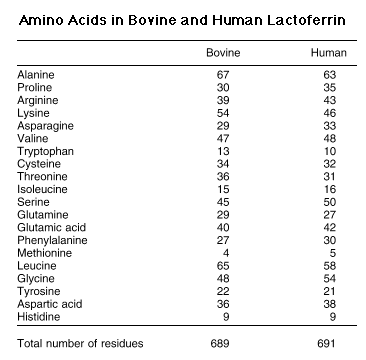A Closer Look At Lactoferrin

First isolated from human milk in 1960, lactoferrin (
at right), also known as
lactotransferrin, is an important member of raw bovine (cow's) milk's self-defense system.
A member of the glycoprotein family- a class of large molecules in which a group of sugars teams up with a functional protein, it's found in tears, saliva and other bodily fluids as well.
Over the past few decades, a large number of studies have looked at lactoferrin's many bioactive properties, and ways to commercialize them.
Interestingly, the first 52 amino acids of the nearly 700 that form the molecule are functionally identical to those in human lactoferrin, and appear to be where the bulk of its activity lies. The rest of the molecule is fairly similar as well (see table below).

Lactoferrin seems to derive a large portion of its bioactivity from its unique ability to bind iron, a key element also utilized by tumors and numerous pathogens for growth and reproduction.
It's an effective anti-oxidant, anti-fungal, anti-bacterial, anti-viral, anti-inflammatory, anti-cancer agent and immune-boosting powerhouse. The FDA felt confident enough to approve its use as a spray on beef carcasses to kill E. coli 0157:H7, a particularly virulent disease-causing bacteria.
Speaking of bacteria, lactoferrin is very similar to a sulfate-binding protein found in a major food-borne pest, Salmonella typhimurium. Evolution takes some odd twists and turns on occasion.
As an anti-oxidant, lactoferrin behaves like an iron scavenger, snapping up free iron, which helps inhibit iron-catalyzed free radical damage to cells. Interestingly, the structural cavities where iron binding takes place on the molecule are much larger than needed, suggesting to some researchers that it may also have evolved to deal with certain toxins and foreign substances.
Lactoferrin's anti-fungal/ anti-bacterial properties lie in its competitiveness for iron as well. Candida albicans, responsible for yeast infections if it gets out of hand, doesn't do well in an iron-poor environment. Neither do numerous strains of pathogenic bacteria, such as E. coli, mentioned above.
When it comes to viruses, lactoferrin is especially effective there too. By interfering with their ability to attach to target substrates (cell walls, for instance), the unusually durable adenoviruses, as well as those responsible for herpes, polio and hepatitis are all inhibited.
Lactoferrin also works to regulate specific members of a group of substances called cytokines- the ones responsible for causing inflammation. Cytokines are a broad class of smaller proteins that control communication among immune system cells as well as regulating growth, damage repair and cellular development.
Boosting the immune system is yet another of lactoferrin's functions. It's believed to stimulate or trigger phagocytosis, the engulfing of foreign organisms and waste material by specialized immune cells like macrophages and granulocytes. Additionally, it influences the number, maturity and activation of numerous other immune response cells, such as T-lymphocytes- specialized white blood cells key in protecting the body from pathogenic attack.
As if all that isn't enough, many studies have also shown that lactoferrin can limit or suppress the spread of cancer cells (metastasis) in mice (the word 'murine' in journal articles means mouse). One theory is that the formation of new blood vessels (angiogenesis) necessary for tumor growth is limited by lack of available iron.
Most of the studies that I came across reported little change in lactoferrin activity after heating during typical pasteurization temperatures and times. But under high pressure homogenization/UHT pasteurization (305°F./151°C.) the results were more variable, with some reports of total inactivation.
You might think a substance with this kind of track record would have tons of potential for exploitation in commercial applications, and you'd be right. Especially if the number of studies on this wonder protein are any indication. Raw milk contains lactoferrin in small but effective amounts to protect itself, and if you drink it, to protect you, too!